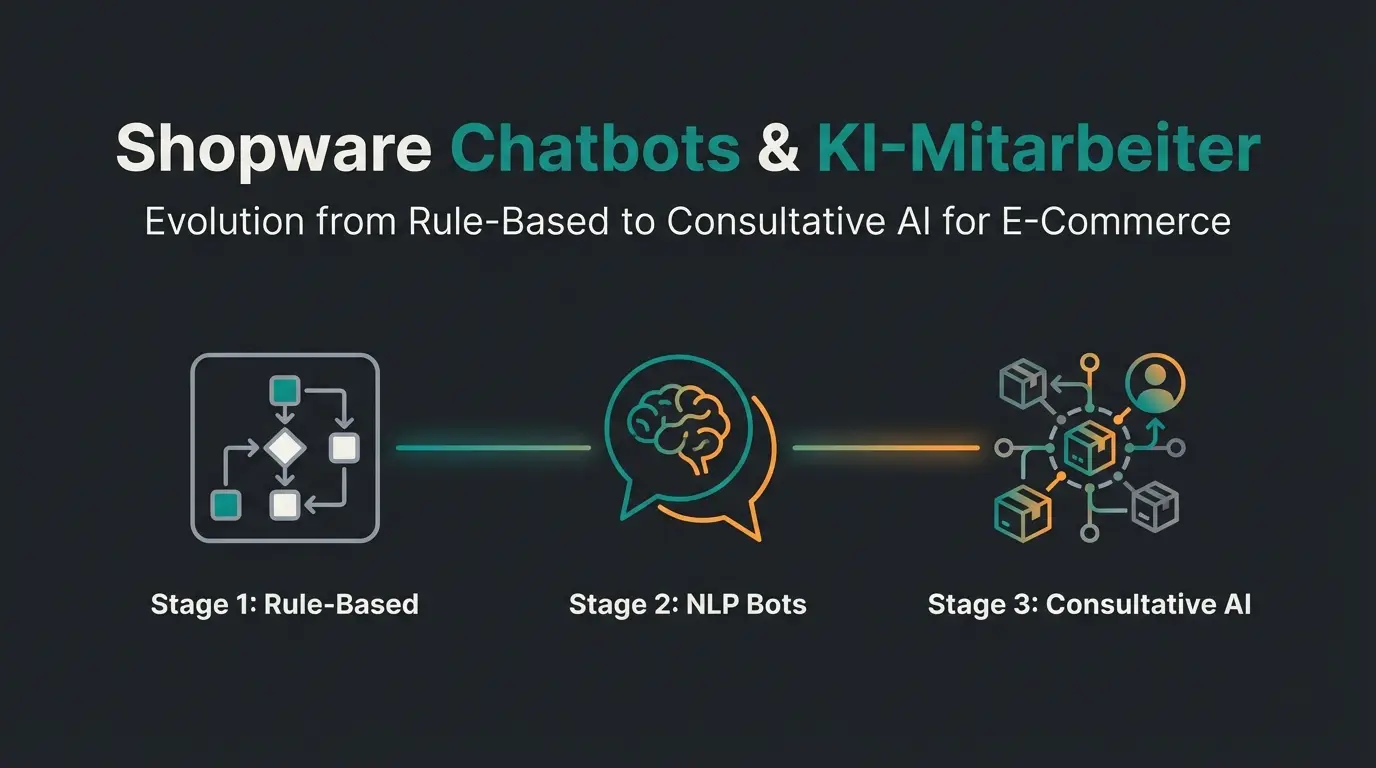AI Chatbot Integration: From FAQ Bot to Intelligent Product Consultation
Transform your AI chatbot integration from a simple support tool into a revenue-generating product consultant. Learn the 3 levels of integration and how to connect PIM data.
Introduction: Why Integration Goes Beyond Support
AI chatbots have developed into an indispensable tool in modern customer service, but their potential reaches far beyond simply answering frequently asked questions. These intelligent systems are based on artificial intelligence and natural language processing to conduct human-like conversations. According to a study by Mordor Intelligence, the global chatbot market is expected to grow to 20.81 billion US dollars by 2029, underscoring the growing importance of this technology.
However, most integration projects aim too low. They focus on 'efficiency' and 'deflection.' For forward-thinking companies, the integration of AI chatbots is not just about cutting costs—it's about automating sales.
While traditional benefits include availability (24/7), efficiency (fast response times), and scalability, the new wave of Conversational AI focuses on personalized product consultation. It's about simulating your best sales engineer, not just your support agent.
The 3 Levels of Integration: Where Do You Stand?
To understand the scope of your project, it is helpful to categorize where your integration sits on the maturity scale. Most competitors stop at Level 2, leaving a massive revenue opportunity at Level 3.
A simple script on the website. Answers generic FAQs based on a static list. High maintenance, low intelligence.
Connected to CRM via API. Can check order status ('Where is my package?'). Good for support, but can't sell.
Deep integration into PIM (Product Information Management) and vector databases. Understands complex attributes ('heat pump compatible with 1980s insulation') and drives conversion.
Strategic Analysis: From Cost Saving to Revenue Generation
Before integrating an AI chatbot, a thorough needs analysis is crucial. Companies should first determine the areas of application where a chatbot offers the greatest added value. Traditionally, this was done by analyzing support tickets. Today, you must analyze your sales friction points.
When setting goals for AI chatbot projects, the definition of measurable Key Performance Indicators (KPIs) must shift from support metrics to sales metrics:
- From Customer Satisfaction (NPS) to Purchase Confidence: Does the user feel ready to buy after the chat?
- From Handling Time to Conversion Rate: We want longer chats if they lead to a sale.
- From Cost Savings to Average Order Value (AOV): Does the bot successfully upsell accessories?
- Revenue Attribution: How much revenue was influenced by the AI consultation?
Industry-specific use cases must be the focus. In Ecommerce, AI chatbots can support complex product consultation, order tracking, and returns processing. In Marketing, they can be used for lead generation, campaign support, and personalized product recommendations based on user intent.
Selecting the Right Technology: PIM vs. FAQ
The choice of technology dictates whether your bot will be a simple greeter or a knowledgeable consultant. There is a variety of options on the market, differing in functionality, complexity, and cost.
On-Premise vs. Cloud Solutions: On-premise solutions offer full control over data and infrastructure but require more internal resources. Cloud-based chatbots are more flexible and easier to scale. According to a study by Cognitive Market Research, the cloud segment dominated in 2022 with a market share of 63.17% and shows the fastest growth.
However, the most critical selection criterion for a 'Consultant Bot' is Data Integration Depth. Can the platform ingest your product feed? Can it read your technical PDF manuals?
| Feature | Standard FAQ Bot | Product Consultation AI |
|---|---|---|
| Data Source | Static Text Lists | Live PIM Data & Vector Database |
| Goal | Deflect Support Tickets | Increase Conversion Rate |
| Context | Linear (Question -> Answer) | Contextual (Remembers constraints) |
| ROI Metric | Cost Savings | Revenue Generation |
An overview of the different types of chatbots can help in decision-making. Qualimero offers a detailed overview of the different chatbot types, from simple rule-based systems to highly developed KI-supported solutions.
Deep Dive: Technical Integration into Your Tech Stack
The successful integration of an AI chatbot into the existing IT infrastructure is a critical step. This goes beyond just pasting a JavaScript snippet on your footer.

1. Connecting to Product Information Management (PIM)
The chatbot must have access to relevant customer information and product data to provide precise and personalized advice. Interfaces to CRM systems and knowledge bases are essential. APIs and middleware solutions facilitate this integration. For a consultative AI, this means structured data (Price, SKU, Dimensions) and unstructured data (Usage instructions in PDFs) must be accessible via a Vector Database.
2. Data Protection and Security (GDPR/DSGVO)
Strict data protection guidelines must be adhered to during integration, especially when the chatbot processes personal data. Encryption, secure authentication, and regular security audits are essential. Compliance with regulations such as the GDPR (DSGVO) must be guaranteed, ensuring server locations and data processing agreements are transparent.
3. The Technical Roadmap
- API Development: Creation of REST or GraphQL APIs for data exchange between the chatbot and existing systems (Shopify, Shopware, Magento, or custom ERPs).
- Data Modeling: Adapting data structures for efficient processing by the chatbot (e.g., cleaning up product attributes).
- Testing Phase: Conducting extensive tests to ensure smooth communication between all systems.
- Monitoring: Implementation of monitoring tools for continuous performance optimization via Webhooks.
Thorough planning and careful implementation of the integration are crucial for long-term success. For a deeper understanding of the technical aspects, we recommend looking at the Qualimero article on how AI chatbots work.
Design and Prompt Engineering: Creating the "Sales Engineer" Persona
In the development of an AI chatbot, conception and design play a decisive role. A well-thought-out chatbot fits seamlessly into the existing communication strategy—but for a sales focus, it needs to sound like an expert, not a robot.
To enable authentic interactions, AI chatbots should be able to conduct natural conversations. This includes the ability to understand context, respond to nuances, and react appropriately. The evolution of chatbots to Conversational AI allows for increasingly human-like dialogues.
Developing the Chatbot Personality: A consistent chatbot personality creates trust. For a product consultant, the tone should be authoritative yet accessible. It should guide the user, not just wait for commands.
Training and Optimization: The "Knowledge Graph"
After conception comes the decisive phase of training and continuous optimization. Only then can the chatbot unleash its full potential and offer real added value.
Building the Knowledge Base: A comprehensive and accurate knowledge base forms the foundation of every successful AI chatbot. This includes:
- Product and Service Information: Detailed descriptions, technical data, prices.
- Consultation Logic: 'If the customer asks for X, check if Y is compatible.'
- Process Knowledge: Workflows, guidelines, and best practices.
The functionality of AI chatbots is largely based on this structured knowledge base. Advanced NLP models are trained with large datasets of real conversations, learning to recognize intentions and extract entities contextually.
Take our free assessment to see if your PIM and product data structure is ready for intelligent integration.
Start Free CheckImplementation Strategy: From Pilot to Profit
The successful implementation and testing phase of an AI chatbot is crucial for its long-term success. A phased introduction allows potential problems to be identified and remedied early on.
Strategies for Phased Introduction
A proven approach is introducing the chatbot in phases. Start with a specific product category or a limited user group (e.g., logged-in B2B customers). This allows for a controlled environment for initial tests and adjustments. Expand the area of application step-by-step based on the insights gained.
A/B Testing and Performance Measurement
A/B tests are an effective instrument for comparing different versions of the chatbot. Test different dialogue flows: Does a direct product suggestion work better, or does asking about the user's budget first lead to higher conversion? Supplement these tests with direct user feedback to obtain a comprehensive picture of the chatbot's performance.

Employee Training: AI as a Colleague, Not a Replacement
The successful integration of an AI chatbot requires not only technical expertise but also the acceptance and competence of the employees. Thorough training is the key to exploiting the full potential of AI technology.
Effective Human-Chatbot Collaboration: Train your employees on how to collaborate effectively with the AI chatbot. Show how the chatbot serves as support—pre-qualifying leads and answering technical specs—so humans can focus on closing the deal. Convey strategies on how complex inquiries can be seamlessly transferred from the chatbot to human employees ('Human in the Loop').
Common Challenges and Solutions
Integrating AI chatbots into existing business processes often brings challenges. To ensure successful implementation, it is important to know these problems and develop appropriate solution approaches.
- Acceptance: Employees may fear job loss. Solution: Position the AI as a tool that removes repetitive drudgery.
- Technical Difficulties: Integration issues with legacy systems. Solution: Use a middleware layer or headless architecture.
- Unexpected User Behavior: Users asking questions the bot wasn't trained for. Solution: Implement a 'fallback' to human agents and use these logs to retrain the model.
An example of successful AI chatbot integration can be found in the customer service sector, where response times were significantly reduced, and customer satisfaction increased through smart automation.
Conclusion: The Future is Consultative
The integration of AI chatbots represents a decisive step in the development of modern sales and marketing strategies. By implementing this technology, companies can not only increase their efficiency but also significantly improve the customer experience and drive revenue.
The future of AI chatbots promises further exciting developments. According to current market forecasts, the global chatbot market will continue to grow rapidly. Companies that successfully integrate AI chatbots and continuously develop them position themselves as pioneers in Conversational AI. They create the conditions for a future-oriented, efficient, and customer-friendly service that sells.
A standard chatbot typically uses static FAQs to answer simple support questions. A consultation AI integrates with PIM systems and databases to understand complex product attributes, offering advice similar to a human sales engineer.
A basic integration (Level 1-2) can take 2-4 weeks. A deep integration with Product Consultation capabilities (Level 3) typically takes 8-12 weeks, depending on data readiness and system complexity.
While many platforms offer 'no-code' builders for basic flows, a deep integration with your ERP or PIM system usually requires developer resources or a specialized partner to set up APIs and Webhooks.
Reputable AI platforms offer GDPR-compliant hosting (often within the EU), data encryption, and features to anonymize user data. Always check for ISO certifications and server locations.
Ready to upgrade from a simple FAQ bot to an intelligent product consultant? Let's discuss your integration strategy.
Book Consultation


